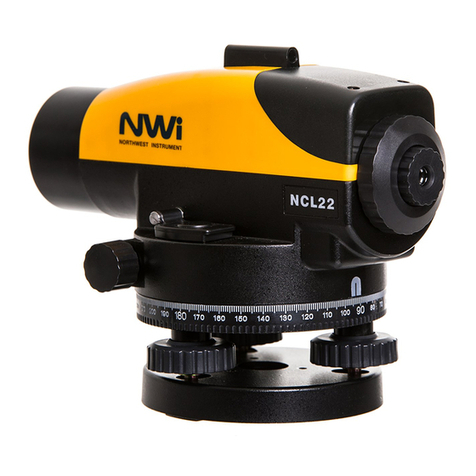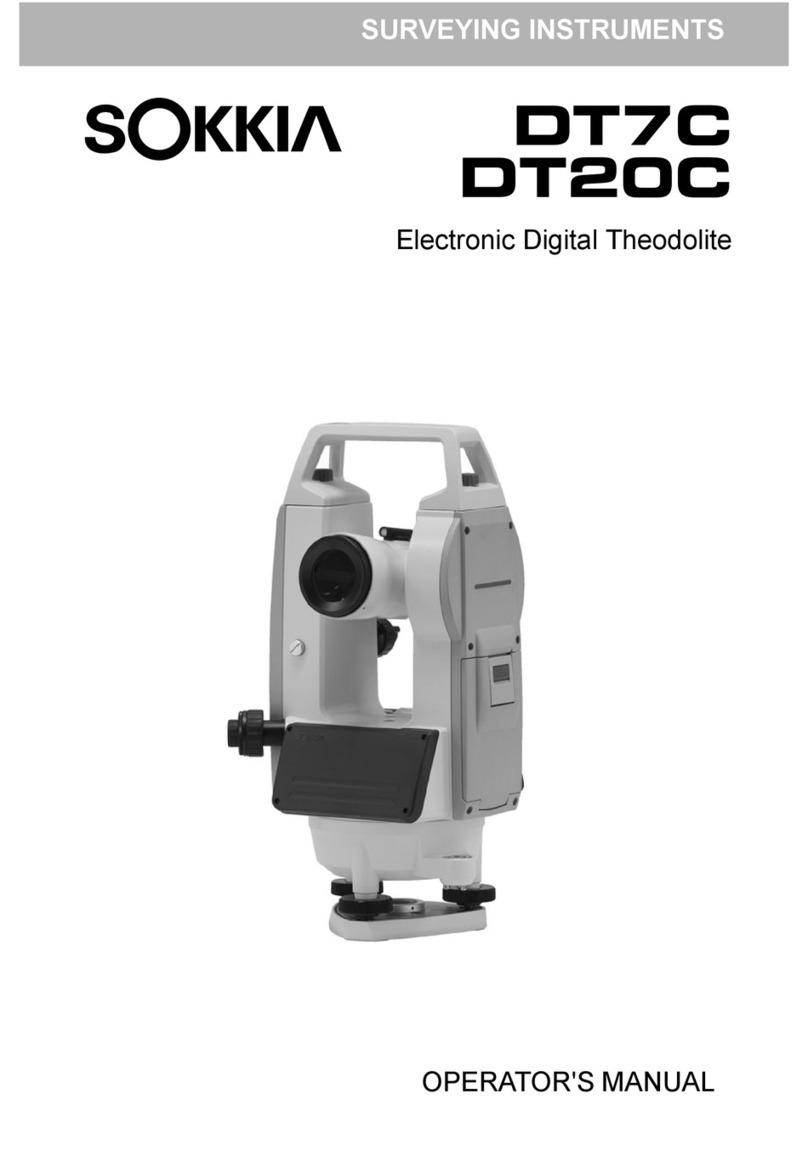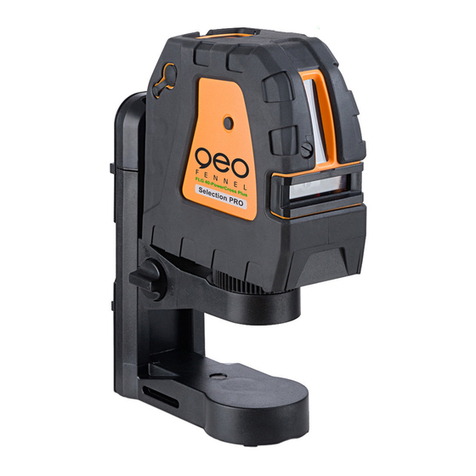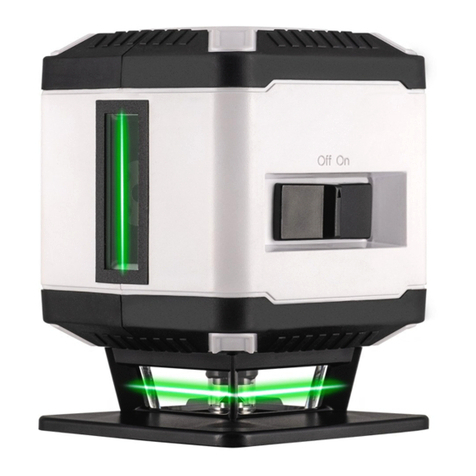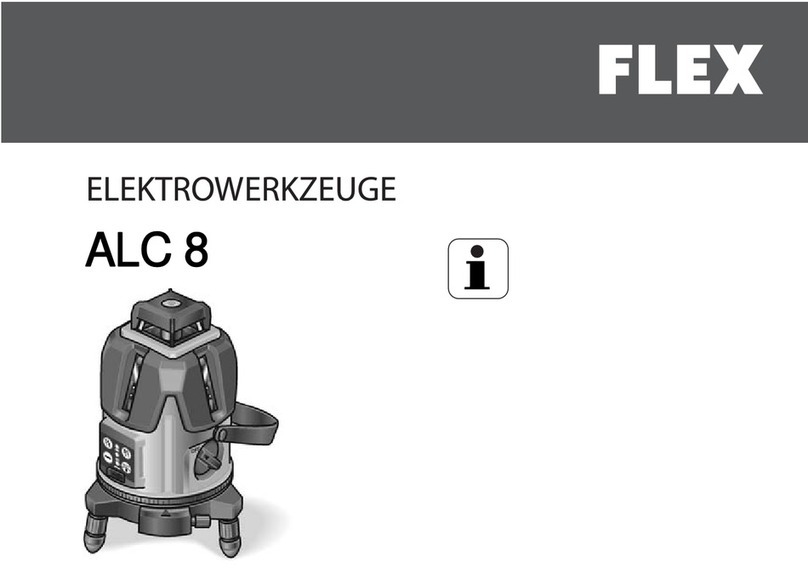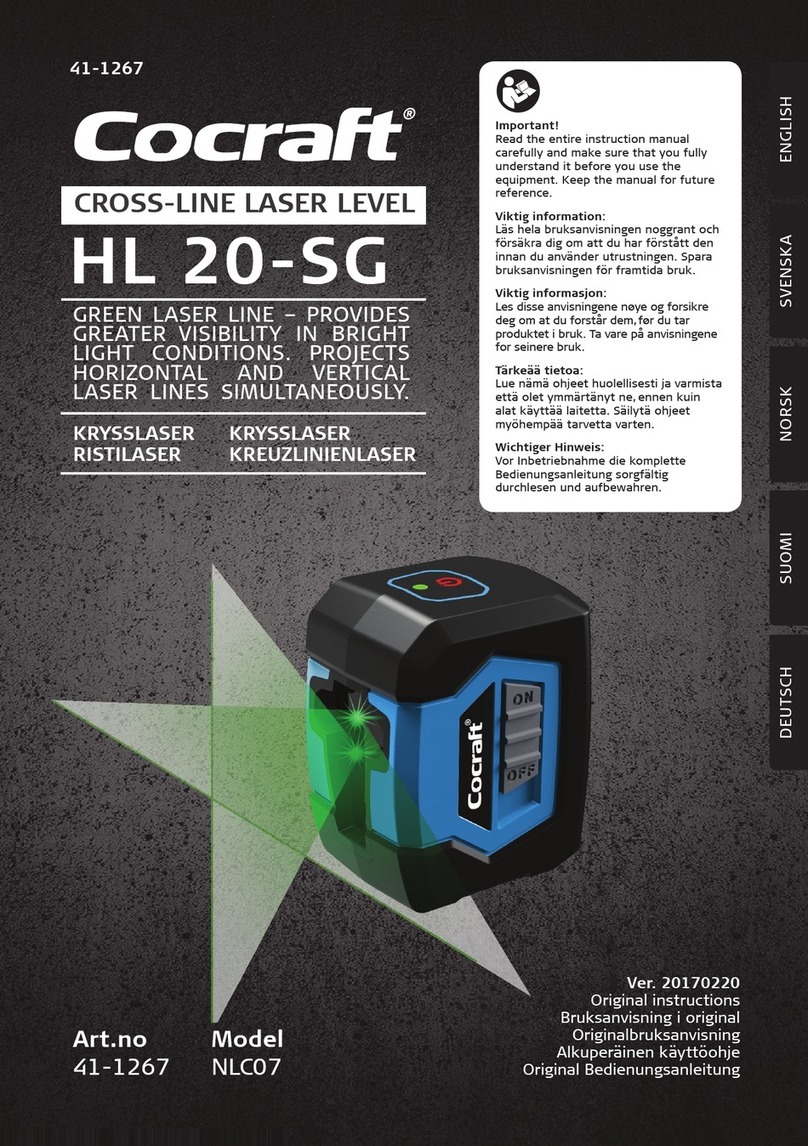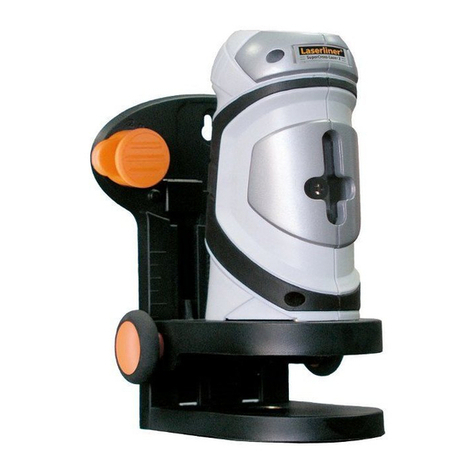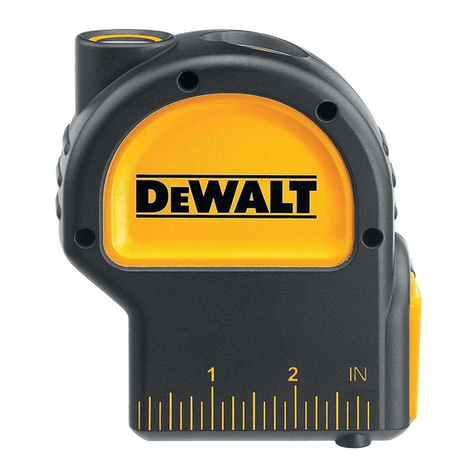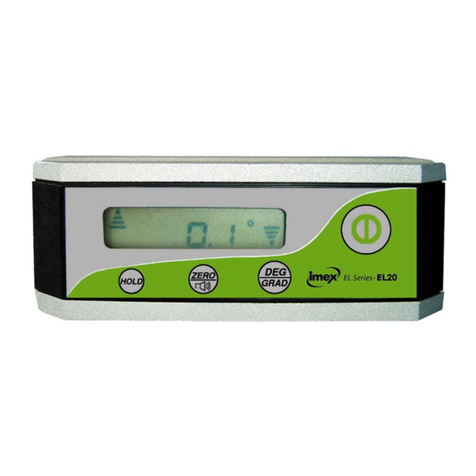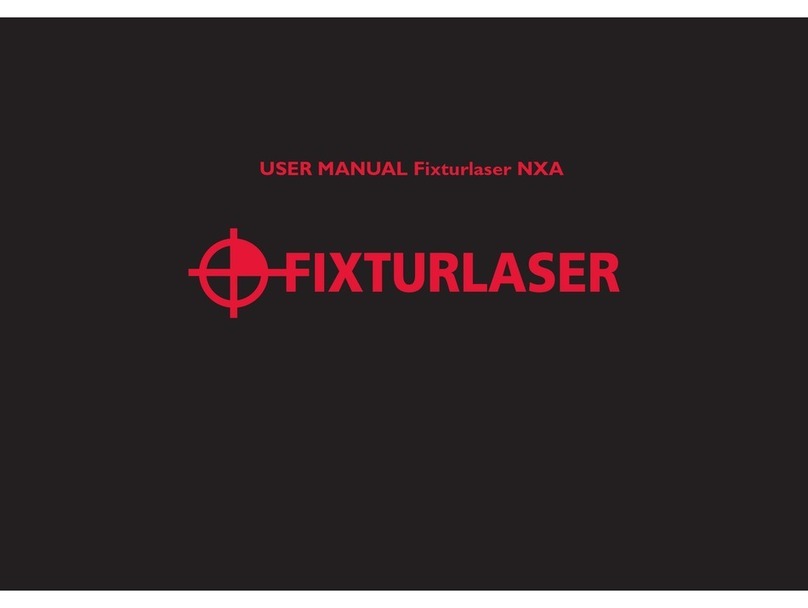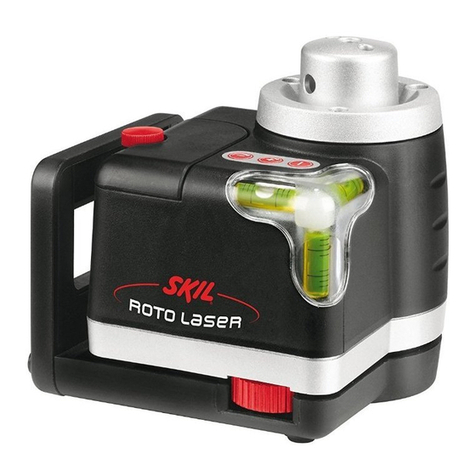Northwest NSL500B User manual

1
Owner's Manual
Owner's ManualOwner's Manual
Owner's Manual
NSL100B BUILDERS LEVEL
NSL500B TRANSIT LEVEL

2
1. CONTENTS
2. Nomenclature page 3
3. Care and Maintenance page 4
4. Using your Instrument
4.1 Setting up your Instrument page 5
4.2 Stadia Measurement page 7
4.3 Measuring Heig t Difference page 8
4.4 Horizontal Circle and Vernier Reading page 9
5. C ecking and Adjusting your Instrument
5.1 Plate Vial page 11
5.2 C eck and Calibration page 11
5.3 Cross airs page 12
6. Specifications page 13

3
2. NOMENCLATURE
NSL100B
NSL500B
Base Plate
Horizontal
Circle
Rubber eyepiece
Cap
Objective
Lens Cover
w/ Sun S ade
Focus Knob
Horizontal
Tangent Knob
Leveling
Screw
Objective Lens
Cover w/ Sun
S ade
Plate Vial
Focus Knob Vertical Clamp Screw
Plate Vial
Horizontal
Circle
Vertical Dial
Leveling
Screw
Base Plate
Horizontal
Tangent Knob
Vertical Tangent
Screw

4
3. CARE AND MAINTENANCE
Your Nort west Siteline Levels and Transit Levels are designed for use
generally in civil engineering and construction as well as for farm, mining and
forestry industries. Wit t e appropriate care, your instrument will need only
minimal routine maintenance and minor adjustments under normal field use.
In case your instrument is damaged or abused, it s ould be taken to a
qualified instrument repair facility. Call Nort west to find t e nearest service
center.
1. T e instrument s ould be kept in its carrying case properly w en not in
use for maximum protection.
2. Keep t e instrument clean and free of dirt and moisture. After use, clean
every part of t e instrument completely before putting it back in its case.
3. If t e instrument becomes wet, wipe off moisture completely, taking special
care of t e lenses by using a soft clean clot or Lens tissue.
4. Do not attempt to clean, oil or repair interior parts. Do not remove any
lenses. T is s ould be done by a qualified repair tec nician.
5. W en working near moving equipment, never leave your instrument
unattended.
6. Always spread t e tripod legs to insure a stable setup. W en setting up on
a pavement or ard surface, try to protect t e legs from slipping by using
tripod ties.
7. After working in dusty locations, remove all dust from t e lenses wit a
clean, soft tissue or clot and brus t e leveling and tangent screws t reads
wit a small brus .

5
8. Make sure not to over-tig ten t e leveling screw, clamp screw or adjusting
screw.
9. It is recommended t at you ave a qualified service tec nician c eck your
instrument periodically

6
4. USING YOUR INSTRUMENT
4.1 Setting u Your Instrument
1) Loosen t e straps around t e tripod legs. Lift t e extension quick-release
clamps. Wit t e tripod closed extend t e legs to roug ly eye level and re-
tig ten t e quick clamps.
2) Position t e legs in a triangular position, making sure t e tripod ead is
approximately level. Press tripod s oes firmly into ground.
3) Take out you instrument gently from its carrying case. Note ow t e
instrument is packed so t at it can be put back in t e same position.
4) Carefully position t e instrument in t e approximate center of t e tripod
ead. Insert t e centering screw into t e base plate, taking care to align t e
t reads properly. Firmly screw t e instrument until it fits tig tly to t e tripod.
However, Make sure not to over-tig ten, cross or strip t e t reads.
5) If you are using a transit level, make sure t e lock lever is engaged.
6) Position t e telescope to t e direction t at aligns wit 2 of t e 3 leveling
screws.
7) Hold one of t e leveling screws (t e one at front of telescope) wit one
and using t umb and forefinger, and old wit your ot er and t e 2
nd
leveling screw (at rear of telescope) wit t umb and forefinger.
8) Turn bot leveling screws wit your bot t umbs and forefingers moving in
opposite directions, loosening one w ile tig tening t e ot er, ensuring bot
screws sitting firmly on t e base plate. Note t e bubble in t e plate vial
always moves in t e direction of your left t umb. You need to move t e
bubble to t e center of t e vial.

7
9) After you ave centered t e bubble, rotate t e telescope 90° so t at t e
telescope is positioned between t e first 2 leveling screws, wit t e 3
rd
screw
at t e front or rear of t e telescope. Use t e 3
rd
screw only to center t e
bubble at t is position.
10) Rotate t e telescope anot er 90° and repeat your leveling procedure till
telescope is turn back to its original position. T e bubble s ould stay at t e
center now t roug out 360°. If t e bubble does not stay at t e center, t e
instrument needs to be c ecked by a qualified tec nician.
11) After leveling t e instrument, turn t e focusing knob to focus on t e
objective. Turn t e knob slowly to avoid moving past a focused image.
4.2 Stadia Measurement
Your Nort west Instrument Siteline Level is equipped wit a stadia reticle so
you can make distance estimates. T e stadia lines are located in t e reticle
as s own in Diagram 4.2A below. Sig t a rod, and take readings of t e
upper and lower stadia lines. Calculate t e difference of two readings and
multiply by 100 to obtain t e distance between t e rod and t e instrument.

8
4.3 Measuring Height Difference
(1) Set up t e instrument at a point approximately alfway between
points A and B. See (Fig 4.3A).
NOTE: T e reticle stadia lines can be used to optically estimate
t e distances. See (Fig 4.2A)
(2) Position t e rod vertically at point A. Take t e reading a (backsig t)
on t e rod at point A.
(3) T en sig t t e rod at point B and take t e reading b (foresig t).
(4) T e difference (a-b) is t e eig t difference ( ) of B from A. (Fig 4.3A)
Example: =a-b =5.25ft-3.25ft =2.00ft
T erefore point B is 2.00ft ig er t an point A. (t e value of will be

9
negative if point B is lower t an point A.)
W en t e distance between points A and B is large or if t e eig t distance
is great:
(1) Divide t e distance into a number of sections and determine t e eig t
difference of eac section.
(2) T e eig t difference between points A and B is t e total of t e eig t
differences of all t e sections.
T e general formula is:
Altitude of t e required point = altitude of known point + total of backsig t
values - total of foresig t values. NOTE: T is simple leveling tec nique as
no error c eck. It is better to measure from A to B and t en measure back to
A so t at t e error of closure can be calculated.
4.4 Horizontal Circle and Vernier Reading
Your instrument is equipped wit an easy to read orizontal circle for simple
angle turning. It is graduated every single degree and is numbered every 10
degrees.

10
Use t e plumb bob provided and set up t e instrument directly above t e
surveying point. Sig t t e objective and set t e orizontal circle to 0 degrees
by turning t e orizontal circle positioning knob. Loosen t e clamp, turn t e
telescope to view t e second observation of your angle. Retig ten t e clamp
and use t e fine motion tangent screw can to bring cross airs precisely on
line wit t e tangent objective. Using t e index line seen in t e circular
viewer, take t e angle reading. T e index line can be used for reading t e
circle in increments finer t an single degrees. T is process is for estimation
but t e average user can position t e index line for finer readings.
NSL500B TRANSIT LEVEL USES AND APPLICATIONS
T e NSL500B transit level as all t e same functions and capabilities as t e
NSL100B level. By unlocking t e lock lever, you make t e instrument
capable of measuring vertical angles.
A vertical dial is attac ed to t e telescope and is read t roug an index
pointer. Vertical angles can generally be read wit in +/- 45°.
This manual suits for next models
1
Table of contents
Other Northwest Laser Level manuals
